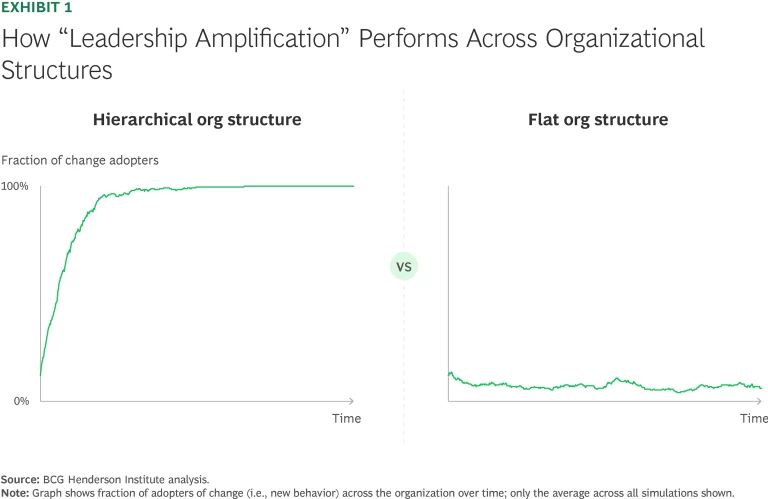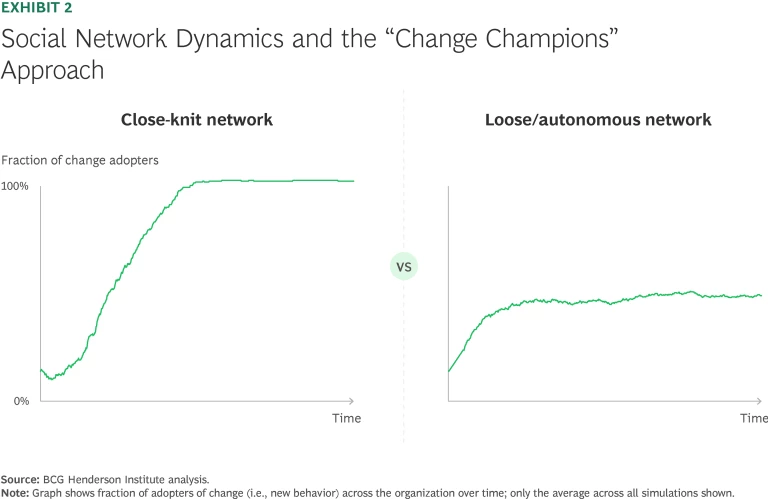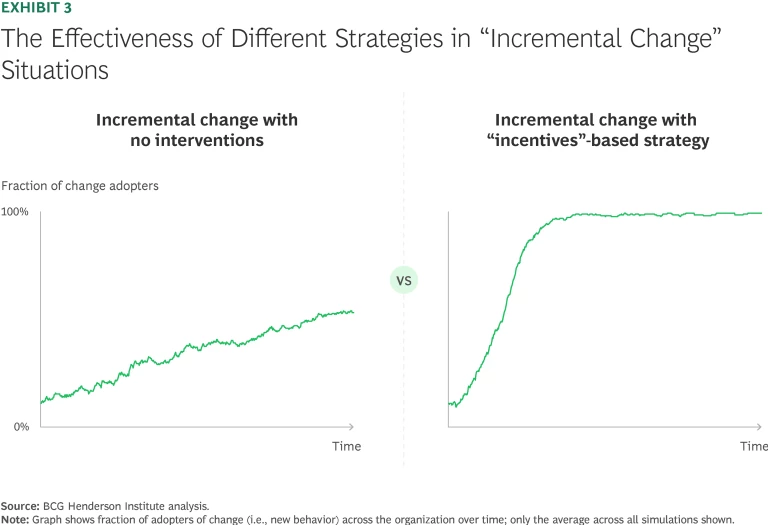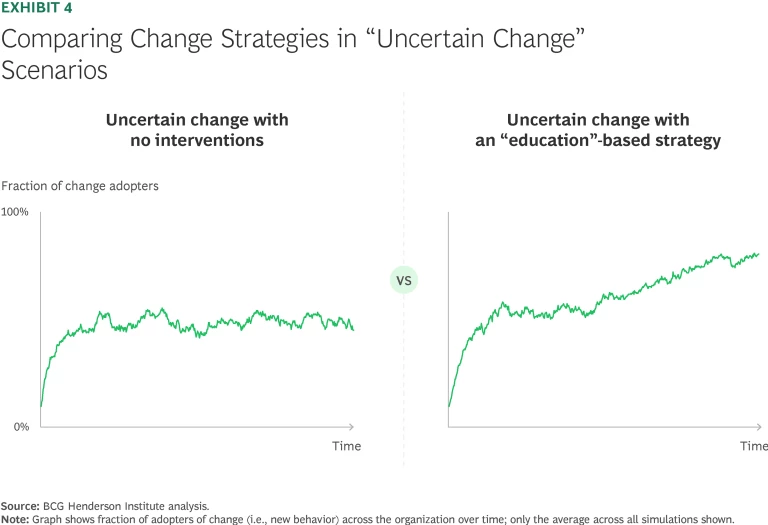Corporate change is hard. BCG research has shown that only a quarter of transformations successfully create value. As a result, change is a favorite subject of management scholars and consultants, who have suggested a wide array of best practices to follow.
No universal formula for successful change exists because change is not monolithic: it is not one type of problem requiring one type of solution. Thus, relying on best practices or replicating approaches that were successful in the past is insufficient. Instead, we argue that the most effective approach to change is contingent on the situation the company finds itself in and the challenge it is facing. In other words, leaders should reconceive change as a strategic challenge, rather than a management exercise.
So how can you identify which factors matter, and how should you account for them? You can’t afford trial and error in your next change situation, so we built an agent-based model to simulate how companies adopt change.
(See “About Our Research”)
Simulating Successful Change
One factor to account for is org structure. Consider how Microsoft and Spotify reacted to the emergence of cloud computing technology—each with its own recipes for success. Microsoft’s pivot to a cloud-first business model was initiated by its then-new CEO Satya Nadella, who made transitioning to the cloud his top mission—relying on established hierarchies to drive change across the
In our model, agents represent employees, each with unique characteristics—such as their openness to change and their receptiveness to peer or leadership influence. These employees can be organized into different types of networks, mirroring the organizational structure of firms.
Once the network is established, we introduce a change to it, such as a new technology or behavior that leadership wants to see adopted. Each agent then continuously updates its behavior according to individual preferences and the actions of peers. To investigate how different change strategies influence the degree and speed of adoption, we can test an array of potential interventions, like the introduction of incentives, as the simulation unfolds.
Through our simulations, we identified four contingencies that change programs need to account for:
Organizational Structure. As the example of cloud computing adoption illustrates, organizational structure matters. In an established hierarchy, amplifying the leader allows change to cascade from level to level. In our model, the central agent—the leader—influences his direct reports, who in turn convince their teams to alter their behavior. As a result, change spreads quickly throughout the entire organization. (See Exhibit 1.)
But what if the organizational structure is instead flat and decentralized? In this context, amplifying top leadership has no meaningful impact because there is no hierarchical structure that can propagate the change—and adoption remains minimal across our simulations.

BCG Henderson Institute: Discover new thinking shaping the business landscape
Social network. While the org structure is easily visible, it is not the only determinant of how change spreads within the firm. Just as crucial are the connections among employees, which may extend beyond formal teams. Spotify, for example, fosters a highly integrated social network by encouraging peer-to-peer skill exchange and interdisciplinary knowledge sharing, meaning that employees have many connections to peers—even beyond their immediate
In such a tightly knit social network, employees are highly receptive to peer influence. As such, an effective change strategy is to identify well-connected employees and convince them to adopt the change first. This will encourage others in their network to make the switch, thus propagating the new behavior. Spotify’s change strategy centered on demonstrating to its top engineers how much of their time would be freed up from tedious tasks like maintaining infrastructure. These influential employees turned into advocates of the new technology, driving change across their teams. Other tactics might rely on providing incentives—such as bonus payments, career growth opportunities, or public recognition—to create well-connected early adopters.
Our simulations also show that tightly knit social networks can be a double-edged sword, as the same close connections that enable change to spread through social contagion can also lead to the formation of pockets of resistance—where each individual sticks with the old behavior because their closest peers do so, too. In our simulations, such issues could be overcome using targeted interventions.
Crucially, there is not a one-to-one relation between org structure and social network; both factors need to be considered when designing change programs. There are hierarchical organizations with tightly knit social networks—think of the military—and flat structures with loose social connections. Video game studio Valve is a famous example of the latter. Its employees self-organize and work on projects they find
In the case of looser social networks—where each agent has fewer connections to peers—our simulations show that a strategy relying on social contagion through champions of change is ineffective. (See Exhibit 2.) Employees’ behaviors are less influenced by peer pressure and are instead guided by expectations of how the change may benefit them personally.
The key to unlocking change is to heighten awareness of these benefits. One way to do this is to educate employees by sharing success cases or testimonials, or through demonstrations that show how daily workflows may become more efficient. Crucially, these education programs need to cover the entire network, given the absence of social contagion.

Scale of the change. Beyond organizational context, the scale of the change itself—how much disruption it causes employees day-to-day—is a key contingency that must be accounted for as leaders devise a more strategic approach to change. This contingency can be considered on a spectrum from incremental change (like switching to a new communication platform) to fundamental change (like transitioning from in-office to remote work or adopting AI or automation tools that significantly alter one’s daily workflow).
At either end of this scale, success requires different change approaches. For incremental change, the effort of adoption is low, but so is the potential benefit to employees. As a result, they may struggle to see the benefits of altering their behavior, thus lacking the motivation to make a switch. Without intervention, our simulations of this situation result in limited adoption of the change. In this scenario, change leaders must create extrinsic motivation, for example, through incentives. (See Exhibit 3.)
At the other extreme, fundamental changes require deeper overhauls of behaviors. However, these changes may also entail larger benefits for the individual employee. Assuming the requisite effort cannot be lowered substantially, a resulting key imperative for leaders is to educate employees about the benefits, turning them into motivators for making a change.

Take Walmart’s e-commerce transformation, for
Certainty about the impact of the change. Finally, leaders need to consider how sure employees are about the impact of the change. A change may provide a clear, immediate, and personal benefit to the employee adopting it—for example, the move from a paper-based to a mobile-friendly expense reimbursement system, which enables faster submission and reimbursement of claims. When the impact of change is certain, leaders can focus on how to factor the scale of the change into their design of change programs.
However, change benefits may also be uncertain. For one, the payoffs may accrue not to the employee adapting their behavior, but elsewhere in the organization. A classic example is the higher effort required from salespeople to adopt a new customer relationship management system. They need to capture detailed customer interactions and deal progress, but the short-term benefit of their added work is felt in finance and accounting teams, which gain access to more accurate revenue tracking and forecasts.
Employees may also be wary of long-term implications of a change: for example, while GenAI tools unlock immediate productivity benefits, employees may also be wary about how the use of such tools may affect their creativity; they may have data security concerns; or they may be wary of commoditizing their expertise by collaborating with machine intelligence.
Our simulations show that when change impact is unclear, backsliding is common. Employees may try out a new behavior, but when they don’t feel its impact, revert to their old ways—and change adoption stalls. In these situations, leaders need to both educate employees about the benefits of the change (even if they accrue elsewhere in the firm) and reduce anxiety about the novel and unknown. (See Exhibit 4.)
One interesting approach we found for dealing with such a situation is Apple University, launched by Steve Jobs in

From Change Management to Change Strategy
Our simulations have identified four dimensions across organizational context and the nature of the challenge that successful change programs must be designed to account for. But a pre-requisite for leaders is a mindset shift: to think of change as a strategic challenge, rather than believing success depends only on the quality of change management.
To better understand the organizational context in which the change will be implemented, leaders should:
Analyze how influence spreads in the organization. Social networks can be mapped with modern workplace analytics tools, which mine communication data—such as email or Slack interactions—to show how connections extend beyond the org chart. A crucial complement to this analysis is assessing the extent of leadership influence, which can be gauged by reviewing upward or 360°-style feedback from employees to their (direct and higher-level) managers.
Assess the organization’s readiness for change. Sentiment analysis and surveys can measure openness to change, while factors such as employee tenure, cultural differences, or reliance on legacy systems may indicate varying levels of entrenchment.
Understand social dynamics and readiness for change. This can help identify change champions that may serve as evangelists in the next transformation. It may also be beneficial to proactively create change champions where none exist. For example, companies can create internal interest groups around emerging technologies that may become relevant in the future.
Treat transformations as an opportunity to learn. Various parts of the organization may react and respond to change in different ways. Regular pulse checks during transformations, coupled with thorough post-action reviews, are crucial to adapting the approach to change over time.
To develop a deep understanding of the nature of the change itself, leaders should:
Assess the effort required for adoption. For example, how many hours of training are needed or how much time will it take before productivity stabilizes at pre-change levels? This might be gauged with benchmarks or, alternatively, companies can experiment with trial phases in small groups or by conducting “day-in-the-life” simulations, testing new workflows before full deployment.
Assess the potential impact. Change leaders should strive to develop a benefit distribution matrix, pinpointing how much different teams or functions stand to benefit from the change and how soon these benefits will manifest. To assess employees’ certainty about the nature of the change, leaders can investigate whether employees have undergone a similar change before—for instance, one that affected the same part of their workflows. Surveys or interviews can further illuminate what concerns employees might have about the impact of the change on their roles.
Create a change journey. Insights on effort and impact can be put together in a change journey—from current to target state—for different parts of the organization. This can help, for example, to identify where potential discrepancies between effort and benefit that may have to be addressed.
Based on an improved understanding of their organization and the change it is facing, leaders can be more strategic about designing their approach. And, critically, a change strategy should not be set-and-forget. Instead, leaders should continuously observe adoption patterns and refine their strategy accordingly—setting aside past experiences and best practices and instead focusing on the contingencies that can enable success.
About Our Research
As the simulation unfolds, each agent in the network continuously updates their decision to stick with their old behavior or to switch to a new behavior (i.e., to adopt a change). This decision is made based on a utility function, which considers factors including the intrinsic preference of the agent for one behavior; their susceptibility to peer influence (i.e., how likely they are to adopt a behavior that is more popular across agents they are connected to); and their concern for the productivity of the overall firm (which depends on the productivity inherent to each behavior, and their adoption rates across the firm). The utility function also includes a sensitivity parameter, which controls for how responsive the decision to switch behaviors is to the utility difference between them. For each component of the utility function, we set a mean and standard deviation. Actual values for each agent are then drawn from a normal distribution, representing the heterogeneity across people.
At the outset of the simulation, we define the network structure and the productivity (i.e., benefit to the firm) of the old and new behavior. We also define the number of agents, the initial fraction of adopters of each behavior, the duration (number of steps) for which a simulation should run, and the total number of simulations to conduct (to account for randomness between simulations, given the nature of the agents’ utility functions). Moreover, we define parameters for each component of the agents’ utility functions. Finally, we define characteristics of the nature of the change. In particular, we can define its scale (i.e., how different the new behavior is in terms of productivity vs. the old behavior), the predictability of its impact (i.e., how certain agents are about the aforementioned scale characteristic), and its reversibility (i.e., whether the productivity of different behaviors may change over time).
During the course of the simulation, we can then introduce a set of interventions, which act on specific agents or the company as a whole, to alter their behavior (by influencing components of their utility functions). Interventions include incentives (which change the inherent preferences for different behaviors), education (which increase the accuracy with which agents update their preferences), and amplification (which alter the influence certain agents exert on their connections; in the special case of “leadership amplification,” the leader of the network (the central node) not only influences directly connected nodes (akin to a CEO and their direct reports), but rather influences all agents across the network, simulating a kind of “halo effect” of top leadership).
Overall, this model allows us to simulate different combinations of organizational structures, social networks, change challenges, and interventions, which we use to test the differential effectiveness of various change strategies.





